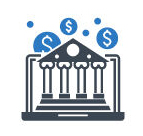CRMs are revolutionizing the way lending practices are conducted. By leveraging the power of customer relationship management, banks are able to gain a deeper understanding of their customers and their needs, resulting in more informed lending decisions and improved loan terms for borrowers. The following are the ways in which CRM for banks is changing the lending industry:
 1. Speed and Convenience: Take advantage of CRM technology to improve your bank’s lending operations. It provides a comprehensive view of borrowers’ financial history, and credit score. Automating data collection and analysis reduces evaluation time, improving efficiency and customer service. CRM technology transforms the lending industry by providing informed decision-making tools, streamlined operations, and enhanced customer experience. Stay caught up – embrace CRM technology today!
1. Speed and Convenience: Take advantage of CRM technology to improve your bank’s lending operations. It provides a comprehensive view of borrowers’ financial history, and credit score. Automating data collection and analysis reduces evaluation time, improving efficiency and customer service. CRM technology transforms the lending industry by providing informed decision-making tools, streamlined operations, and enhanced customer experience. Stay caught up – embrace CRM technology today!
 2. Personalized Service: Banks that utilize CRM have a powerful tool in their hands to effectively categorize customers and offer tailor-made services that cater to their unique requirements. This results in a highly personalized customer experience, leading to elevated levels of customer satisfaction and loyalty. Don’t miss out on the opportunity to enhance your customer experience – adopt CRM today.
2. Personalized Service: Banks that utilize CRM have a powerful tool in their hands to effectively categorize customers and offer tailor-made services that cater to their unique requirements. This results in a highly personalized customer experience, leading to elevated levels of customer satisfaction and loyalty. Don’t miss out on the opportunity to enhance your customer experience – adopt CRM today.
 3. Better Loan Terms: Banks can significantly benefit by gaining a deeper understanding of their customers. By doing so, they can offer loan terms that are more competitive, resulting in lower interest rates and better repayment plans for borrowers. This approach not only helps banks to attract more customers, but also ensures that they retain existing ones by providing them with a satisfying borrowing experience.
3. Better Loan Terms: Banks can significantly benefit by gaining a deeper understanding of their customers. By doing so, they can offer loan terms that are more competitive, resulting in lower interest rates and better repayment plans for borrowers. This approach not only helps banks to attract more customers, but also ensures that they retain existing ones by providing them with a satisfying borrowing experience.
 4. Increased Transparency: Customer Relationship Management (CRM) is a powerful tool that enables banks to provide their customers with a transparent loan process. By utilizing pre-built indicators and statistical reports, banks can offer real-time work results to borrowers. This level of transparency instills trust and confidence between the bank and the borrower, ultimately leading to better customer satisfaction and a smoother loan process.
4. Increased Transparency: Customer Relationship Management (CRM) is a powerful tool that enables banks to provide their customers with a transparent loan process. By utilizing pre-built indicators and statistical reports, banks can offer real-time work results to borrowers. This level of transparency instills trust and confidence between the bank and the borrower, ultimately leading to better customer satisfaction and a smoother loan process.
 5. Improved Customer Retention: CRM has become crucial for banks to enhance their lending experience and improve customer retention. By leveraging CRM, banks can analyze customer data to identify trends, make informed business decisions, and develop targeted marketing campaigns, increasing engagement and loyalty. CRM has become a game-changer for the banking sector, providing banks with the necessary tools to keep their customers happy.
5. Improved Customer Retention: CRM has become crucial for banks to enhance their lending experience and improve customer retention. By leveraging CRM, banks can analyze customer data to identify trends, make informed business decisions, and develop targeted marketing campaigns, increasing engagement and loyalty. CRM has become a game-changer for the banking sector, providing banks with the necessary tools to keep their customers happy.
 6. Reduced Risk: In banking, using Customer Relationship Management (CRM) tools allows for a more comprehensive evaluation of a borrower’s creditworthiness and repayment capacity. Banks can make informed decisions and provide tailored financial solutions to their customers by leveraging the data collected through CRM systems. This ultimately leads to a more efficient and effective lending process, benefiting both the lender and the borrower.
6. Reduced Risk: In banking, using Customer Relationship Management (CRM) tools allows for a more comprehensive evaluation of a borrower’s creditworthiness and repayment capacity. Banks can make informed decisions and provide tailored financial solutions to their customers by leveraging the data collected through CRM systems. This ultimately leads to a more efficient and effective lending process, benefiting both the lender and the borrower.
 7. Increased Efficiency: Banks can significantly improve their overall efficiency and performance by implementing automation for certain aspects of their lending process. This automation helps them save time and resources, resulting in increased profitability. It allows banks to streamline their lending operations and reduce the potential for errors or delays while providing a more seamless and convenient experience for their customers.
7. Increased Efficiency: Banks can significantly improve their overall efficiency and performance by implementing automation for certain aspects of their lending process. This automation helps them save time and resources, resulting in increased profitability. It allows banks to streamline their lending operations and reduce the potential for errors or delays while providing a more seamless and convenient experience for their customers.
 8. Improved Compliance: By utilizing this technology, banks can enhance their ability to comply with regulations governing the loan process. This results in better risk management, increased operational efficiency, and reduced compliance-related costs. The solution empowers banks to maintain compliance with regulatory requirements and stay ahead in an ever-changing regulatory environment.
8. Improved Compliance: By utilizing this technology, banks can enhance their ability to comply with regulations governing the loan process. This results in better risk management, increased operational efficiency, and reduced compliance-related costs. The solution empowers banks to maintain compliance with regulatory requirements and stay ahead in an ever-changing regulatory environment.
 9. Greater Insight: Customer Relationship Management (CRM) is a powerful tool that helps banks better understand their customers’ behavior and preferences. Banks can identify patterns and trends that would otherwise go unnoticed by analyzing the data collected from various sources, such as social media activity, transaction history, and feedback surveys. By leveraging this valuable information, banks can make better-informed lending decisions that meet their customers’ needs and expectations.
9. Greater Insight: Customer Relationship Management (CRM) is a powerful tool that helps banks better understand their customers’ behavior and preferences. Banks can identify patterns and trends that would otherwise go unnoticed by analyzing the data collected from various sources, such as social media activity, transaction history, and feedback surveys. By leveraging this valuable information, banks can make better-informed lending decisions that meet their customers’ needs and expectations.
 10. A better bottom line: Banks can improve their lending process using CRM software by streamlining and automating various tasks such as loan application processing and approval. Additionally, a CRM allows banks to make more informed decisions by providing valuable insights into customer behavior. This enables banks to create personalized loan offerings. Ultimately, these efforts increase profitability, making it a win-win situation for banks and customers.
10. A better bottom line: Banks can improve their lending process using CRM software by streamlining and automating various tasks such as loan application processing and approval. Additionally, a CRM allows banks to make more informed decisions by providing valuable insights into customer behavior. This enables banks to create personalized loan offerings. Ultimately, these efforts increase profitability, making it a win-win situation for banks and customers.
